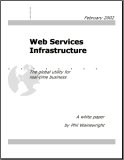|
| stories |
|
| commentary |
|
| resources |
|
| services |
|
Glossary lookup:
|
 Web Services Infrastructure: The global utility for real-time business — February 2002 (updated Oct), 20 pages, free download (PDF, 76k)
Web Services Infrastructure: The global utility for real-time business — February 2002 (updated Oct), 20 pages, free download (PDF, 76k)
|
|
 |
 |
 |
Loosely Coupled weblog
|
Friday, January 30, 2004
Thursday, January 29, 2004
Wednesday, January 28, 2004
|
|